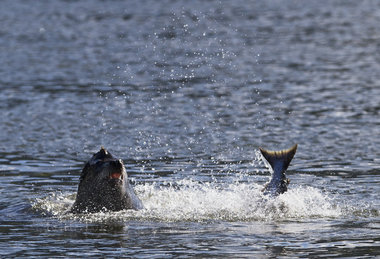forum
library
tutorial
contact

Sea Lion Task Force to Meet Again
by Bill RudolphNW Fishletter, October 21, 2011
|
the film forum library tutorial contact |

|
Sea Lion Task Force to Meet Againby Bill RudolphNW Fishletter, October 21, 2011 |
 The NMFS sea lion task force will reconvene Oct. 24 to again come up with recommendations for dealing with marine mammal predation on salmonids at Bonneville Dam.
The NMFS sea lion task force will reconvene Oct. 24 to again come up with recommendations for dealing with marine mammal predation on salmonids at Bonneville Dam.
The task force has already done this once before -- and ultimately supported increased trapping and the lethal removal of some animals. But litigation to block that drastic action caused the states to suspend and reapply for authorization to lethally remove some sea lions.
The 9th Circuit Court wanted the federal fish agency to explain why such drastic action was needed to remove sea lions when the human harvest rate on ESA-listed spring chinook was up to four times that of the pinnipeds, but the current litigation may be moot since the feds withdrew the states' authorization for lethal take of some sea lions last July.
Since then, the feds say new analysis suggests that the pinnipeds may be taking more of the run than previously estimated. A decision memo that was also released said new data suggested the sea lions may be consuming far more chinook than originally estimated, from 4.2 percent of 2010's relatively large run, to nearly 13 percent of the 2005 run. The previous estimates for pinniped predation in those years were 2.2 percent and 3.5 percent, respectively.
Also, two years of pilot studies with PIT- and acoustic-tagged adults has pointed to a 12-percent or so unexplained mortality for spring chinook for adults traveling upriver between Astoria and Bonneville Dam, where thousands of sea lions and seals hang out.
Just last week, a bill to make it easier to lethally remove sea lions from the area around Bonneville Dam was voted out of committee in the House of Representatives. If passed, it would allow Columbia Basin tribes to kill some sea lions if they were heavy predators on salmon near the dam, as well as states, and speed up the application process with the feds to 30 days. Each applicant group would be allowed to kill up to 10 sea lions.
In a report released earlier this month, The Corps of Engineers said the removal program was "gradually reducing" the numbers of sea lions and their predation on salmonids. But they said the large numbers of new male sea lions that showed up in 2010, along with the end of removal actions in 2011 will make further analysis of the program "more difficult."
The report said California sea lions were estimated to have consumed only about 1.1 percent of the spring run, while Stellar sea lions ate about .5 percent. In 2008, they were estimated to have eaten about 3 percent of the run.
The latest report said 13 California sea lions were captured this year -- 9 were branded and given acoustic and/or GPS transmitters. Four that had been previously branded were also given transmitters. All were released.
The Corps said three of the California sea lions were on the list for removal and seven more would have qualified if the states' permit had not been vacated for most of the season. When the removal authority was still valid, one sea lions was trapped and removed in Astoria in late May.
The report said the situation in 2010, when more new sea lions were observed than returning ones, was likely a "one-time event." They said more than 150 individual California Sea Lions have returned one or more years to the dam.
learn more on topics covered in the film
see the video
read the script
learn the songs
discussion forum
